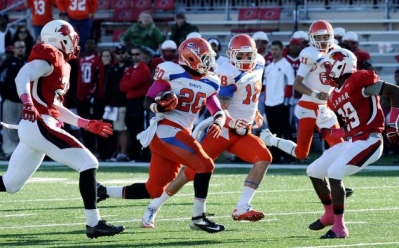By Mike Kuchar
Senior Research Manager
X&O Labs
Twitter: @MikeKKuchar
Case 1: Communicating Personnel Groupings and Formations
Introduction
 In this case, we focused our research on how coaches were grouping formations and personnel to make them more relatable to players. We’ve found coaches can have upwards of 8 personnel groupings and over two dozen formations. We wanted to find ways in which coaches are simplifying their offensive packages to utilize as many groupings/formations as possible without jeopardizing the learning curve of their athletes.
In this case, we focused our research on how coaches were grouping formations and personnel to make them more relatable to players. We’ve found coaches can have upwards of 8 personnel groupings and over two dozen formations. We wanted to find ways in which coaches are simplifying their offensive packages to utilize as many groupings/formations as possible without jeopardizing the learning curve of their athletes.
Number of Personnel Groupings
Our research below indicates the amount of personnel groupings coaches are using per game. The majority of coaches, 38 percent, use four personnel groupings per game.
Reader Responses:
We surveyed coaches and asked the following question:
Q: What has been the most efficient way to group or relate the names you use in your personnel groupings to make it more understandable for your players?
The responses are below. We kept them anonymous in order to protect identity.
Color System:
“We use colors, with the darker the color the more run-focused the grouping can be. For example, Black is our Maryland-I formation, which almost 90% run. White and Grey colors are two back pistol formations, which are closer to 50/50 run/pass.”
Default Formations:
“All our formation calls come off our base formation, which is double twins. The X and H are on left side and Y and Z are on right. We use one word for the formation such as ‘Ace.’ Then we have specific words that tell our wide receivers and tight ends where to be. Such as ‘Ace Hit,’ this tells the H to come across formation. This has worked better for us than when we just said ‘Pro Right or Left’ because it tells each kid where to be. Bronco and Buffalo tells our B back (H back) where to align. An example would be Bronco ‘Yo.’ B would be to right and Y would go over to left to create a Pro twins look.”
Weather Names:
“We use weather names; 10 means lightning; 11 means thunder and 20 means tornado.”
Vocalizing Formations:
“We simply yell out ‘two-back’ if we want the H-back into the game and we'll call out a receiver (usually a slot) for him to replace.”
Picture Boards:
“We use boards with pictures to move players from the same personnel groupings and formations to different places within the called formation.”
Hand Signals:
“We use hand signals and fingers to represent formations. After we put up the different fingers we make a fist to add a tight end to the formation. An example is four fingers represent a 2x2 formation. Now if we make a fist right after putting up the two fingers we know one side will have a tight end.”
Word Associations Based on Positions
“We use names that relate to the primary focus of the personnel group. For instance, ‘hammer’ could equal a big fullback and our best tailback. ‘Jumbo’ could equal our biggest skill guys. ‘Falcon’ could equal three wide receivers and ‘Trojan’ could equal our three best running backs.”
“The best way is to associate by position or by physical attributes of your different players. Examples include ‘big’ personnel for your taller receivers or extra tight ends. ‘Extra’ personnel for your entire X are to be in the game at certain positions. ‘Zebra’ personnel for all of your Z's to be in the game at certain positions. ‘Speed’ personnel is used for your fastest guys at certain positions, and so-on and so-forth.”
“We use names to identify personnel groups that are used for multiple formations. ‘Sam’ equals no tight end. ‘Ted’ equals one tight end. ‘Henry’ equals one H-back. ‘Hannah’ equals one tight end and one H-back.”
“Like most teams, we designate positions with letters. We name the personnel groups with words containing the letter or letters of the position or positions within the group who is/are the ‘adjuster(s).’ Let's say that the personnel group is Horns. This group includes Z & J (outside receivers) S & H (slots) and R (RB). The H is the ‘adjuster’ In Horns personnel Tiger, the H aligns in the slot to the right side of the formation regardless of hash. In Horns personnel Lion, the H aligns in the slot to the left side of the formation regardless of hash. In Frogs personnel, the Z & J are still on the field and S is still on the field, but H Back is replaced by the F and the F is the ‘adjuster.’ In Frogs personnel Tiger, the F aligns in the slot to the right side of the formation regardless of hash. In Frogs personnel Lion, the F aligns in the slot to the left of the formation regardless of hash. Tiger and Lion are 2 x 2 formations. In 3 x 1 sets, all positions have a ‘home base’ and we have tags to move them around within the formation. In Thunder personnel, the Z remains on the field, but now the tight end (T) and the H Back (H) are part of the group along with S and R (RB). Both T and H are ‘adjusters’ in Thunder personnel formations.”








